| |
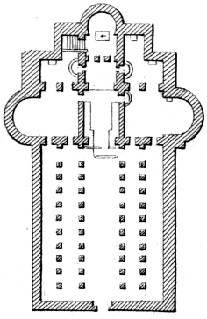
Plan of the Church of Bethlehem (325 and 527-65), dedicated to the Virgin by St. Helena.
Seroux
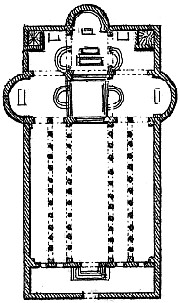
Plan of the Church of Bethlehem, erected in the fourth century by the Empress Helena, in honor of the Virgin and the Saviour on the spot where he was born, already celebrated by the birth of David. This temple is of beautiful proportion, adorned with a great number of columns, and originally the interior was covered with precious marbles, which were taken away by the Turks to enrich their mosque of Jerusalem. In an enclosure adjoining are all the buildings necessary for the service of the church, lodging for the priests and religious orders and the pilgrims who visit it--cloisters, cells, hospitals, and private oratories; a small church dedicated to St. Catherine built on the spot where St. Jerome worked at the translation of the Bible; the stable or grotto in which Jesus Christ was born, transformed into a subterranean church. The worship is now shared between the Armenians, the Copts, the Syrians, the Greeks, and the Latins, who in turn dispute the possession of this church. It is said to be on the same site where Adrian celebrated the fêtes in honor of Adonis, and that it was to repair this profanation that Helena and Constantine erected this magnificent temple. A letter addressed by this emperor to Macarius, bishop of Jerusalem, exhibits his desire for its sumptuous decoration in all parts. Ut omnia templa . . . . hujus oedificii dignitate superarentur, the Mahometans had soiled it, the Crusades purified it. The city of Jerusalem offers a still more striking example of like vicissitudes. On Mount Moriah, one of the hills of its ancient enclosure, David raised an altar, surrounded by Solomon with the famous temple, one of the wonders of the world; Titus destroyed it; Adrian planted on its site a grove consecrated to Jupiter; Julian endeavoured to reconstruct it; the Saracens under Omar built a mosque; it became a church in the bands of the Crusaders, and they again abandoned it to the Turks, who restored it to the worship of Mahomet.
Seroux
| |
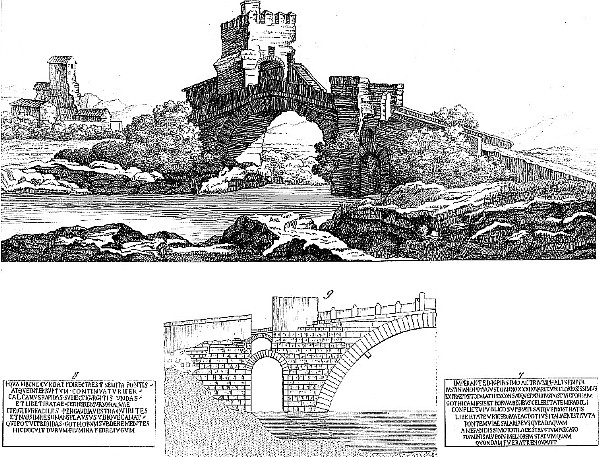
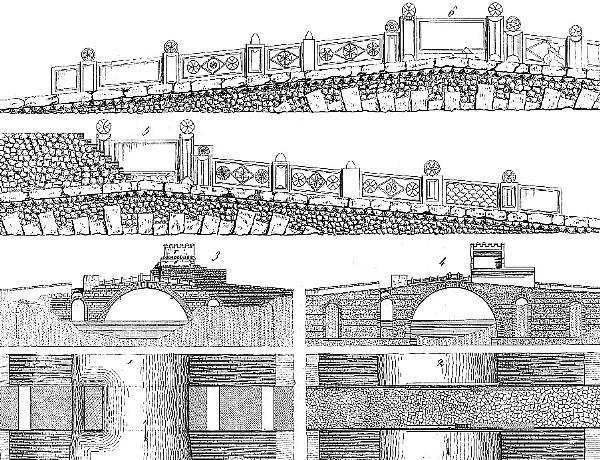
1. Plan of the bridge at the level of the water.
2. Plan of the roadway, the pavement is in irregular polygons.
3. Side elevations.
4. Longitudinal section of the bridge, showing the construction; the tower is of much later date.
5 and 6. Details of the parapet; the ornaments are rudely executed; in the center are two panels, on the sides of which, next to the raodway, are the inscriptions 7 and 8.
7. Inscription, from which we learn that this bridge, demolished to the level of the water by Totila, was rebuilt by Narses, in the thirty-ninth, and the last year of the reign of Justinian, in 565 of the Christian era.
8. Inscription in verse in honor of Narses.
9. Elevation of one half of the bridge on a large scale, showing the construction.
10. Perspective view of the bridge.
Seroux
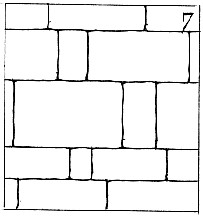
Another example of the irregular employment of blocks of stone in the construction of the bridge Salaro, rebuilt by Narses in the sixth century.
Seroux
|